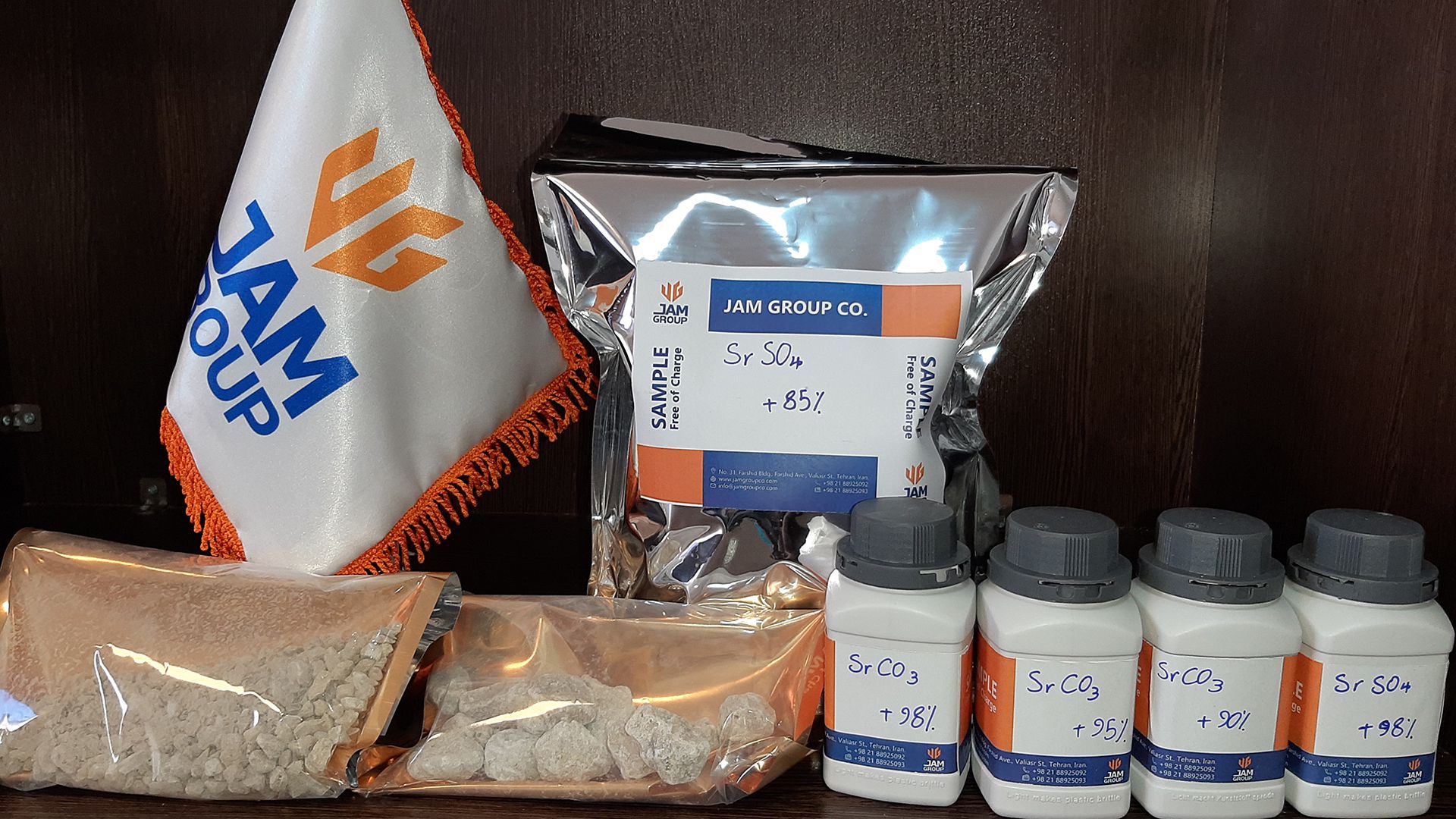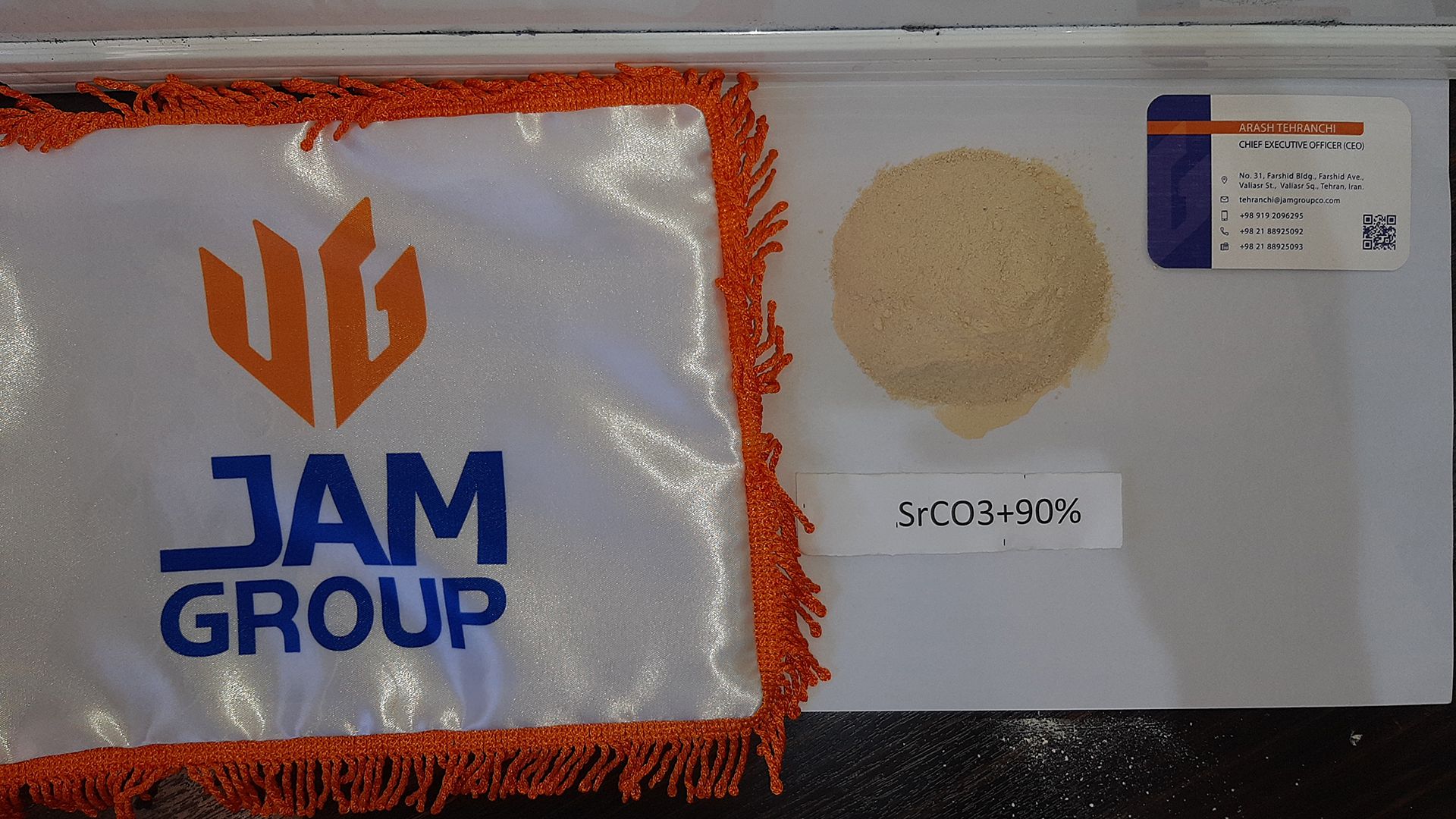Strontium carbonate (SrCO3) is the carbonate salt of strontium that appears as a white or grey powder. It can be found in nature as the minerals celestine and strontianite. Strontium carbonate is a white powder that has no odor or taste. As a carbonate, it is a weak basic and so reactive with acids. Otherwise, it is safe and stable to use. Due to its properties, SrCO3 functions in a wide range of industries. Primarily, it serves in producing other strontium compounds. It also involves making ferrite magnets, fireworks, the iridescent glass of color televisions, and ceramic glaze. Strontium carbonate manufacturers provide this substance in various amounts of purity to meet market demands.
JAM Group Co. is a reputable strontium carbonate supplier in various grades of purity and particle sizes. Different Iranian celestine mines and two well-equipped companies make JAM Group confident in presenting a pure product that meets international certificates. This company manufactures, sources, and distributes Strontium Carbonate throughout the world. As such, every in-demand customer worldwide can rely on this Iran strontium carbonate provided by a powerful strontium carbonate supplier, JAM Group. This material can be used as a reliable component in many industries, such as ceramic or magnet manufacturing raw material that leads to a perfect outcome. Please contact us if you would like more information about our products.

What is Strontium Carbonate?
Celestite (SrSO4) and strontianite (SrC03) are the two main strontium minerals, with the former being the more abundant and the primary commercial source of strontium. While celestite in its concentrated form (i.e., as SrSO4) has diverse uses, most strontium applications involve producing strontium compounds, mainly carbonate, nitrate, hydroxide, and chloride. These chemicals have a wide range of benefits and can also serve as the building blocks for creating other chemicals. Strontium carbonate, which has two primary applications, is without a doubt the most significant of these chemicals:
- 65% of the strontium carbonate produced goes to this end use as an ingredient in the manufacture of glass for color television tubes;
- More than 20% of the strontium carbonate supplied to this market is used to make ferrite magnets.
Before going into detail about the properties of strontium carbonate, the most important derivative of strontium, it is vital to have a short glance at strontium and its characteristics.
What is Strontium?
The chemical element strontium has the atomic number 38 and the symbol Sr. It is a soft, silver-white, yellowish metallic element that is an alkaline earth metal with strong reactivity to chemicals. A thick layer of dark oxide forms when the metal is exposed to air. Like its two vertical neighbors in the periodic table, barium, and calcium, strontium exhibits physical and chemical characteristics. Interestingly, both strontium and strontianite take their names after the Scottish village of Strontian, near which the mineral was found in 1790 by Adair Crawford and William Cruickshank. The following year, the mineral’s crimson-red flame test color allowed scientists to determine that it was a newly discovered element.
The properties of strontium, a divalent silvery metal with a faint yellow hue, are mainly in the middle of and comparable to those of its group neighbors, barium and calcium. Compared to calcium and barium, it is softer. It also has lower melting and boiling temperatures than calcium (842 and 1484 degrees Celsius, respectively).

Strontium Carbonate Properties
The carbonate salt of strontium, strontium carbonate (SrCO3), is a white or gray powder. The mineral strontianite is as it appears in nature. It is a water-insoluble source of strontium that may be quickly heated to form other strontium compounds, like the oxide (calcination). When carbonate compounds are exposed to weak acids, carbon dioxide is also released. The powder form of strontium carbonate is white, tasteless, and odorless. Because it is a carbonate, a weak base, it reacts with acids. Otherwise, it is stable and secure to use. It cannot dissolve in water (0.0001 g per 100 ml). However, if the water is saturated with carbon dioxide, the solubility rises dramatically to 0.1 g per 100 ml.
Different Grades of Strontium Carbonate
Based on the chemical’s degree of purity, each chemical receives a grade designation. A lower chemical-grade class will arise from the presence of more contaminants in the chemical composition. Each cargo of strontium carbonate is assigned a grade class to inform users of a chemical’s purity and potential applications. Lower-grade chemicals usually serve as cleaning, industrial solvents, or solvents in producing goods other than food. Only chemicals of high-purity grades can be used for food or medicinal applications.
Strontium carbonate can be obtained in most purity amounts, from low purity to highly pure grades, such as 99.99%. It is worth mentioning that Strontium carbonate manufacturers improve optical quality and utility as scientific standards by providing ultra-high purity and high-purity compositions. Still, only some producers can give customers a high-purity product because the manufacture of strontium carbonate with a reliable purity level demands advanced tools and knowledge. Accordingly, two methods have been employed by producers to provide a pure outcome:
- The black ash method that produces a 98% pure outcome with 2% impurities;
- The soda ash method that produces a 97% pure outcome with 3% impurities.
Producers endeavor to follow applicable ASTM testing standards to manufacture a variety of standard grades, including:
- Electronic grade;
- Mil-Spec (military grade);
- ACS;
- Reagent and Technical Grade;
- Food, Agricultural, and Pharmaceutical Grade;
- Optical Grade;
- USP;
- EP/BP (European Pharmacopoeia/British Pharmacopoeia).
It is also vital to note that each grade of strontium carbonate can function in a specific industry, so every company in need must ask the manufacturer to receive the grade that meets the application. In this case, customers must consider another factor, the average particle size, because this factor also becomes essential in different usage.
Strontium Carbonate Production Process
Metallic strontium and compounds containing strontium (such as our intended chemical, strontium carbonate, and strontium oxide (SrO), strontium hydroxide (Sr(OH)2), strontium chloride (SrCl2), and strontium nitrate (Sr(NO3)2)) play a significant role in the industry. As mentioned before, the most popular strontium compound is strontium carbonate (SrCO3), used most frequently in technology and business to make magnetic materials and colorful television tubes. Additionally, thanks to its ferrite compound, it works to refine zinc as a powerful magnet and as a bearing lubricant. As a result, many strontium carbonate manufacturers try to use various methods to produce this substance as efficiently as possible.
The first thing we should know about the producing strontium carbonate and other strontium compounds is the natural recourses of strontium. Minerals such as celestite (SrSO4) and strontianite (SrCO3) contribute to making strontium metal. The principal source of strontium ore is strontium sulfate (SrSO4). Strontianite has a higher strontium content, but the high calcium content constrains its industrial use. Celestite has more economic value as a result while having a lower strontium content. Obtaining strontium carbonate is the most crucial stage in manufacturing metallic strontium and other compounds based on strontium. Two standard techniques have been used to produce strontium carbonate. The following subsections describe these two methods in a detailed manner.
1st Method
Black ash is the first option. It is interesting to know that it is the commercial method currently used to convert celestite ore to strontium carbonate.
Ground celestite is combined with finely divided carbon and calcined at around 1000° C to produce black ash comprising strontium sulfide (SrS) from the ore and gaseous byproducts carbon dioxide (CO2) and carbon monoxide (CO). Hot water leaches the water-soluble strontium sulfide from the black ash. The aqueous solution is then separated from the undissolved ore contaminants by settling and filtering. By carbonating the aqueous solution with CO2 or, more frequently, reacting the aqueous solution with sodium carbonate, the dissolved strontium sulfide is changed into strontium carbonate. Using standard solids-liquid separation techniques, the strontium carbonate precipitated from the solution is recovered and dried.
2nd Method
The direct conversion method is the alternative way to make strontium carbonate. Before beginning this procedure, the ore needs to undergo intense purification. By washing the ore with acid during this refinement procedure, calcium and iron compounds are removed from the ore. HCl and H2SO4 have typically favored acids. Strontium carbonate forms when refined ore combines with sodium carbonate or ammonium carbonate. The twofold decomposition process, an ion exchange reaction between sulfate and carbonate, is another name for the direct conversion method. The literature describes this reaction as decreasing in core since it is both thermodynamically and kinetically quite sluggish.
The Drawbacks of Traditional Methods
Both methods introduced in this section hold specific flaws that make the strontium production process costly and, in some cases, lead to an impure outcome. For example, the black ash method has drawbacks, such as the need for high process temperatures and the need to dispose of sodium sulfide or hydrogen sulfide reaction byproducts when sodium carbonate is used as the carbonate source (when CO2 is the carbonate source).
Therefore, chemists work to develop solutions to reduce the drawbacks of high costs and excessive process stages. Using strontium nitrate as a strontium source is an alternative to producing strontium carbonate using the traditional black ash method. Celestite ore could be utilized to make this strontium nitrate. An aqueous solid nitric acid solution has typically been used to dissolve strontium carbonate, resulting in the formation of strontium nitrate and carbon dioxide, which were then combined to make strontium nitrate. Lime is used to precipitate and eliminate impurities from the resulting aqueous solution, and then strontium nitrate is extracted by evaporative crystallization from the filtered solution.
Strontium Carbonate Applications
As one of the most significant strontium compounds, strontium carbonate (SrCO3) finds application in numerous industrial and technological sectors. It is specifically utilized as an additive and as a component of magnetic ferrites in manufacturing glass cathode-ray tubes for TV and computer monitors. Other uses include producing specialty glassware, pyrotechnics, paints, medicine, and photocatalysts for the aqueous destruction of organic pollutants, such as strontium titanate and zirconate, as well as improved ceramic materials.
Moreover, strontium carbonate functions in other industries that may not be as well known; for instance:
- It serves to refine sugar and certain medications and create strontium oxide and salts;
- It is a common element in glazes used in the ceramics industry. Additionally to serving as a flux, it changes the color of some metallic oxides.
In Making Strontium Compounds
It is possible to create various strontium salt compounds from the strontium carbonate produced by either the black ash procedure or other methods. Strontium carbonate suppliers provide this substance to manufacture strontium chloride, strontium oxide, strontium nitrate, and many others. Strontium carbonate and nitric acid, for instance, combine to create strontium nitrate. By combining strontium carbonate with the proper acid, other strontium compounds can be made in a manner similar to this.
It is worth mentioning that strontium nitrate is typically prepared by dissolving strontium carbonate with a strong aqueous nitric acid solution, thus forming strontium nitrate and carbon dioxide. Impurities in the aqueous solution are precipitated with lime and removed before strontium nitrate is obtained from the filtered solution by evaporative crystallization.
In Manufacturing Magnets
Strontium carbonate also functions as a Magnet Manufacturing raw material due to its unique properties. Hard ferrite magnets are produced using strontium carbonate (or barium) and iron oxide. Due to their high coercivity, the materials are particularly resistant to demagnetization, a necessary quality for a permanent magnet. They have a strong magnetic permeability as well. These allegedly ceramic magnets are affordable and frequently used in home items like refrigerator magnets. The magnetic field strength H ranges from 30 to 160 kiloampere turns per meter at the maximum magnetic field B of approximately 0.35 tesla.
In Producing Color Televisions
The production of iridescent glass for color television tubes also uses strontium carbonate. There is a chance for x-ray creation because many TV components run at thousands of volts. These parts might generate x-rays that can escape from the CRT or television receiver. This inadvertent x-ray emission must be managed since it could be dangerous. As a result, strontium carbonate is extensively employed in the production of CRT televisions. The X-rays produced by the television tubes are significantly reduced (to virtual nil) by this chemical and other substances. However, these tubes have almost lost their significance due to contemporary flat-panel technology.
In Fireworks
Fireworks are a class of low-explosive pyrotechnic devices used for entertainment and aesthetics. They are most frequently used in pyrotechnic displays, which combine numerous devices in an outdoor setting and are sometimes known as fireworks displays or fireworks shows. In this sector, strontium carbonate functions as a low-cost colorant. Strontium and its salts produce a vivid red hue in flame. The point is that, in contrast to other strontium salts, carbonate salt is typically favored due to its affordability and non-hygroscopicity. Pyrotechnics benefit significantly from its capacity to neutralize the acid.
As a Ceramic Manufacturing Raw Material
The ceramic glaze industry utilizes strontium carbonate, a particularly brittle source of strontium oxide. It is a flux for the glaze that encourages more scratch- and craze-resistant glaze surfaces. It is used to replace barium carbonate and is comparable to calcium. Interestingly, strontium carbonate is frequently suggested as a barium alternative to creating matte glazes. It is advised to use roughly 75% as much and test beforehand to ensure the same color reaction. However, since it reacts with water’s SO4– ions to create a substance that is not nearly as insoluble as BaSO4, strontium cannot replace barium as a precipitator of soluble salts in clay bodies.
About JAM Group’s Strontium Carbonate
Various producers take part in the strontium carbonate market, but JAM Group Co. is among them due to several key factors. This company brings considerable experience in the fields of earth substances, chemical reagents, and many other related areas allowing it to supply customers with Strontium Carbonate with the highest quality and purity. JAM Group’s Strontium Carbonate is available in different quantities and specifications to suit your industrial or scientific needs. Customers can easily ask for different grades and particle sizes presented in various packings based on international standards. It helps you experience a smooth purchase guaranteed with a reliable backup.
JAM Group Co. offers its products in standard and unique packing ways. It ensures the safety of each package regarding transportation. However, customers can go for their intended methods of packing the strontium carbonate and choosing a specific way of shipping. The good news is that you can contact us to find out more about each strontium carbonate grade’s technical, research, and safety information.
Conclusion
Strontium carbonate (SrCO3) is a powder that is either white or gray in color. Strontianite and celestine are natural sources of this substance. It counts as one of the most often utilized strontium compounds. Strontium carbonate manufacturers use several methods to create this substance, the black ash process being the most common. However, increasing environmental awareness and regulatory requirements have prompted the development of alternative techniques, frequently based on the ash process. Outcomes usually hold different amounts of purity, each for a specific application, leading to various grades. The two main uses of strontium carbonate are as an additive in the manufacture of color television tubes and as a component in the fabrication of permanent ceramic ferrite magnets. Other applications include the production of strontium metal, glass, pyrotechnics, paints, dryers, and zinc.

